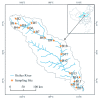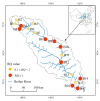Distribution, Sources, and Risk Assessment of Organochlorine Pesticides in Water from Beiluo River, Loess Plateau, China
- PMID: 37368595
- PMCID: PMC10302601
- DOI: 10.3390/toxics11060496
Distribution, Sources, and Risk Assessment of Organochlorine Pesticides in Water from Beiluo River, Loess Plateau, China
Abstract
The Loess Plateau has been a focus of public discussion and environmental concerns over the past three decades. In this study, in order to investigate the effect of OCP pollution in water of the Beiluo River, concentrations of 25 OCPs at 17 locations in the water were examined. The results showed that the concentration of ∑OCPs in the water ranged from 1.76 to 32.57 ng L-1, with an average concentration of 7.23 ng L-1. Compared with other basins in China and abroad, the OCP content in the Beiluo River was at a medium level. Hexachlorocyclohexane (HCH) pollution in the Beiluo River was mainly from the mixed input of lindane and technical HCHs. Dichlorodiphenyltrichloroethane (DDT) pollution was mainly from the mixed input of technical DDTs and dicofol. Most of the OCP pollution came from historical residues. The risk assessment results showed that hexachlorobenzene (HCB) and endosulfan had high ecological risks in the middle and lower reaches of the Beiluo River. Most residual OCPs were not sufficient to pose carcinogenic and non-carcinogenic health risks to humans. The results of this study can provide a reference for OCP prevention and control and watershed environmental management.
Keywords: Beiluo River; distribution; organochlorine pesticides; risk assessment; sources.
Conflict of interest statement
The authors declare no conflict of interest.
Figures





Similar articles
-
[Seasonal Distribution, Composition, and Source Apportionment of Polycyclic Aromatic Hydrocarbons and Organochlorine Pesticides in the Main Stream of the Luanhe River].Huan Jing Ke Xue. 2017 Oct 8;38(10):4194-4211. doi: 10.13227/j.hjkx.201703107. Huan Jing Ke Xue. 2017. PMID: 29965203 Chinese.
-
Concentrations and distributions of 18 organochlorine pesticides listed in the Stockholm Convention in surface sediments from the Liaohe River basin, China.J Environ Sci Health B. 2015;50(5):322-30. doi: 10.1080/03601234.2015.1000172. J Environ Sci Health B. 2015. PMID: 25826100
-
Residual levels, phase distributions, and human health risks of OCPs in the middle reach of the Huai River, China.Environ Sci Pollut Res Int. 2024 Mar;31(14):22012-22023. doi: 10.1007/s11356-024-32534-4. Epub 2024 Feb 24. Environ Sci Pollut Res Int. 2024. PMID: 38400976
-
Historical contamination and ecological risk of organochlorine pesticides in sediment core in northeastern Chinese river.Ecotoxicol Environ Saf. 2013 Jul;93:112-20. doi: 10.1016/j.ecoenv.2013.04.009. Epub 2013 May 15. Ecotoxicol Environ Saf. 2013. PMID: 23683900 Review.
-
Spatial Distribution and Ecological Risk Assessment of Residual Organochlorine Pesticides (OCPs) in South American Marine Environments.Curr Environ Health Rep. 2020 Jun;7(2):147-160. doi: 10.1007/s40572-020-00272-7. Curr Environ Health Rep. 2020. PMID: 32180163 Review.
Cited by
-
Distribution of Polycyclic Aromatic Hydrocarbons and Pesticides in Danjiangkou Reservoir and Evaluation of Ecological Risk.Toxics. 2024 Nov 27;12(12):859. doi: 10.3390/toxics12120859. Toxics. 2024. PMID: 39771074 Free PMC article.
-
Release of polychlorinated biphenyls (PCBs) and organochlorine pesticides (OCPs) from cigarette butts into the aquatic environment: Levels and ecotoxicity.Heliyon. 2024 Oct 9;10(20):e39046. doi: 10.1016/j.heliyon.2024.e39046. eCollection 2024 Oct 30. Heliyon. 2024. PMID: 39640668 Free PMC article.
-
DDT and Its Metabolites in Ethiopian Aquatic Ecosystems: Environmental and Health Implications.Environ Health Insights. 2024 Dec 16;18:11786302241307471. doi: 10.1177/11786302241307471. eCollection 2024. Environ Health Insights. 2024. PMID: 39691351 Free PMC article. Review.
References
-
- Wang X., Zhang Z., Zhang R., Huang W., Dou W., You J., Jiao H., Sun A., Chen J., Shi X., et al. Occurrence, source, and ecological risk assessment of organochlorine pesticides and polychlorinated biphenyls in the water–sediment system of Hangzhou Bay and East China Sea. Mar. Pollut. Bull. 2022;179:113735. doi: 10.1016/j.marpolbul.2022.113735. - DOI - PubMed
-
- Zhang S., Zhao W., Yang C., Li Y., Liu M., Meng X., Cai M. Assessment of currently used organochlorine pesticides in surface water and sediments in Xiangjiang river, a drinking water source in China: Occurrence and distribution characteristics under flood events. Environ. Pollut. 2022;304:119133. doi: 10.1016/j.envpol.2022.119133. - DOI - PubMed
Grants and funding
LinkOut - more resources
Full Text Sources
Miscellaneous

